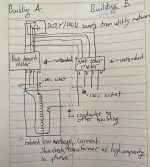ruxton.stanislaw Spammer
Suspended Member
- Location
- Arkansas
- Occupation
- Laboratory Engineer
Hello,
I thought of an idea that could potentially be abused in photovoltaic net metering situations. This is all theoretical of course; I don't have the intention or means to do this.
Anyhow, the idea requires a peak use demand business meter on the same transformer as a typical net metering meter. The idea is to inject a relatively large amount of DC current on to one or all of the phases (as separate circuits) and complete the circuit on the other end of the peak use demand meter. The meter would see current going out of the solar meter and the peak use meter wouldn't care about the extra current coming in, unless it raised the peak use.
You would not be tampering with utilities, but rather, connecting a non-UL approved appliance to a circuit. There is for sure still fraud itself though.
Would this idea work? Does the current need to match the AC wave form? You could do the same thing with a lower voltage AC in phase. What do you think?
Cheers to us thinkers
I thought of an idea that could potentially be abused in photovoltaic net metering situations. This is all theoretical of course; I don't have the intention or means to do this.
Anyhow, the idea requires a peak use demand business meter on the same transformer as a typical net metering meter. The idea is to inject a relatively large amount of DC current on to one or all of the phases (as separate circuits) and complete the circuit on the other end of the peak use demand meter. The meter would see current going out of the solar meter and the peak use meter wouldn't care about the extra current coming in, unless it raised the peak use.
You would not be tampering with utilities, but rather, connecting a non-UL approved appliance to a circuit. There is for sure still fraud itself though.
Would this idea work? Does the current need to match the AC wave form? You could do the same thing with a lower voltage AC in phase. What do you think?
Cheers to us thinkers


